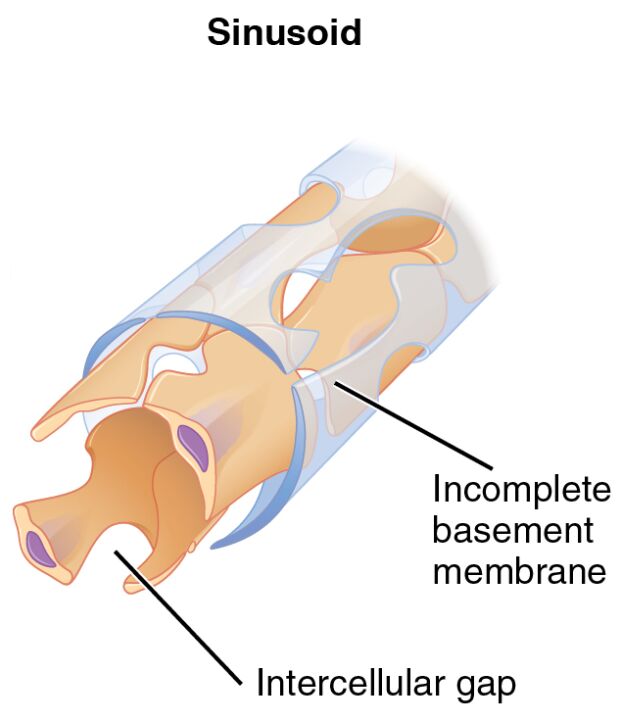Capillaries are the tiny conduits of the circulatory system, enabling the exchange of vital substances between blood and tissues, with sinusoid capillaries offering a unique design for specialized functions. This image illustrates the sinusoid type of capillary, highlighting its distinct anatomical features that support high permeability and cellular interaction in specific organs.

Incomplete basement membrane The incomplete basement membrane consists of discontinuous segments beneath the endothelial cells, allowing greater flexibility and permeability. This structure facilitates the passage of larger molecules and cells, which is critical for the functions of organs like the liver and spleen.
Intercellular gap The intercellular gap refers to the wide spaces between endothelial cells in sinusoid capillaries. These gaps enable the movement of blood cells, such as red blood cells and white blood cells, as well as large proteins, enhancing the capillary’s role in filtration and exchange.
The Role of Sinusoid Capillaries in the Body
Sinusoid capillaries are essential for organs with demanding exchange requirements. Their open structure supports critical physiological processes that maintain overall health.
- They are prominently located in the liver, where they allow hepatocytes to process blood and remove toxins.
- In the spleen, they assist in filtering old or damaged red blood cells from circulation.
- The incomplete basement membrane supports the release of newly formed blood cells from the bone marrow.
- Their design accommodates the unique needs of tissues involved in blood storage and immune function.
Anatomical Structure of Sinusoid Capillaries
The anatomy of sinusoid capillaries is characterized by their irregular and highly permeable design. This structure sets them apart from other capillary types, adapting to the specific needs of certain tissues.
- The intercellular gap is significantly larger than in continuous or fenestrated capillaries, promoting cell passage.
- The incomplete basement membrane features gaps that enhance the exchange of substances.
- Endothelial cells are loosely arranged, with minimal tight junctions to maximize permeability.
- The wider lumen accommodates irregular blood flow, distinguishing them from more uniform capillary types.
Physiological Functions and Importance
Sinusoid capillaries play a key role in supporting the metabolic and immune functions of specific organs. Their permeable nature ensures efficient interaction between blood and surrounding cells.
- In the liver, they enable the uptake of nutrients and the secretion of bile components.
- They facilitate the release of hormones like T3 and T4 from the thyroid gland in certain contexts.
- The intercellular gap allows white blood cells to migrate into tissues during immune responses.
- Their structure supports hematopoiesis in the bone marrow, aiding blood cell production.
Clinical Significance of Sinusoid Capillaries
Understanding the structure of sinusoid capillaries provides valuable insights into various health conditions. Changes in their function can indicate underlying issues that affect organ performance.
- Damage to the incomplete basement membrane can contribute to liver dysfunction in conditions like cirrhosis.
- In the spleen, altered permeability may affect immune cell trafficking and filtration efficiency.
- They are studied in the context of bone marrow disorders, such as leukemia, due to their role in hematopoiesis.
- Therapeutic strategies often target these capillaries to improve detoxification and blood cell release.
Comparison with Other Capillary Types
Sinusoid capillaries differ markedly from continuous and fenestrated types, each serving distinct purposes within the vascular system. This comparison underscores their specialized role.
- Unlike continuous capillaries, sinusoids have a incomplete basement membrane and wider gaps.
- Fenestrated capillaries feature controlled pores, while sinusoids allow larger cellular passage.
- The intercellular gap in sinusoids is more pronounced, contrasting with the tight junctions of other types.
- This structural variation supports their unique functions in filtration and cell trafficking.
Maintenance and Regulation of Sinusoid Capillaries
The body regulates sinusoid capillaries to ensure they meet the dynamic needs of their host organs. These mechanisms maintain their functionality under varying physiological conditions.
- Endothelial cells adjust the size of the intercellular gap in response to blood flow and pressure.
- The incomplete basement membrane is remodeled to balance support and permeability.
- Local factors, such as inflammation, influence their permeability and cellular exchange.
- Hormonal signals help regulate their role in detoxification and immune responses.
In conclusion, the sinusoid capillary, as shown in this image, represents a remarkable adaptation for maximum exchange within the circulatory system. With its incomplete basement membrane and spacious intercellular gap, this capillary type supports vital functions in the liver, spleen, and bone marrow, ensuring efficient filtration, detoxification, and blood cell production. Delving into these features enhances our understanding of the body’s intricate vascular network and its role in sustaining life.

